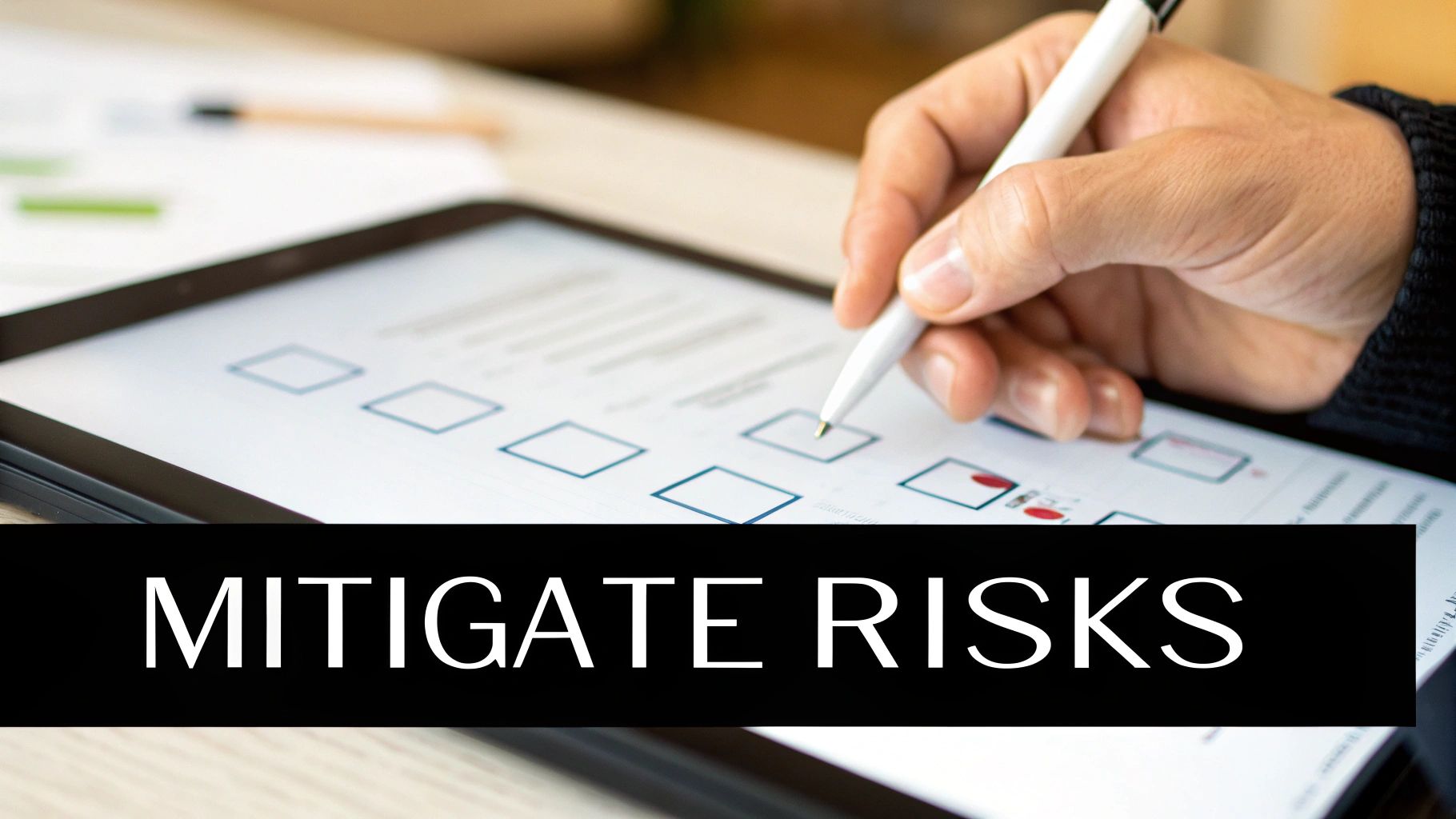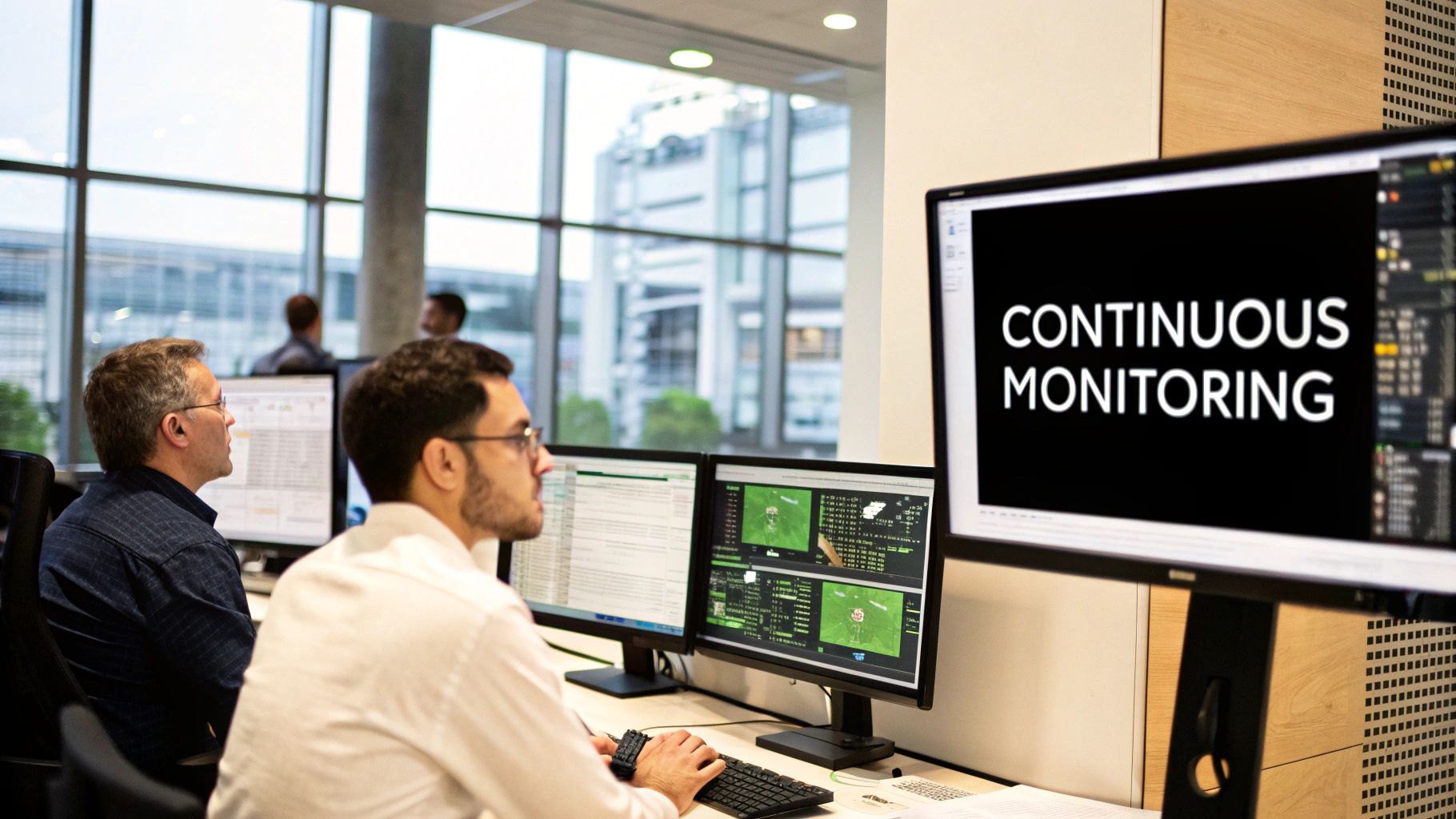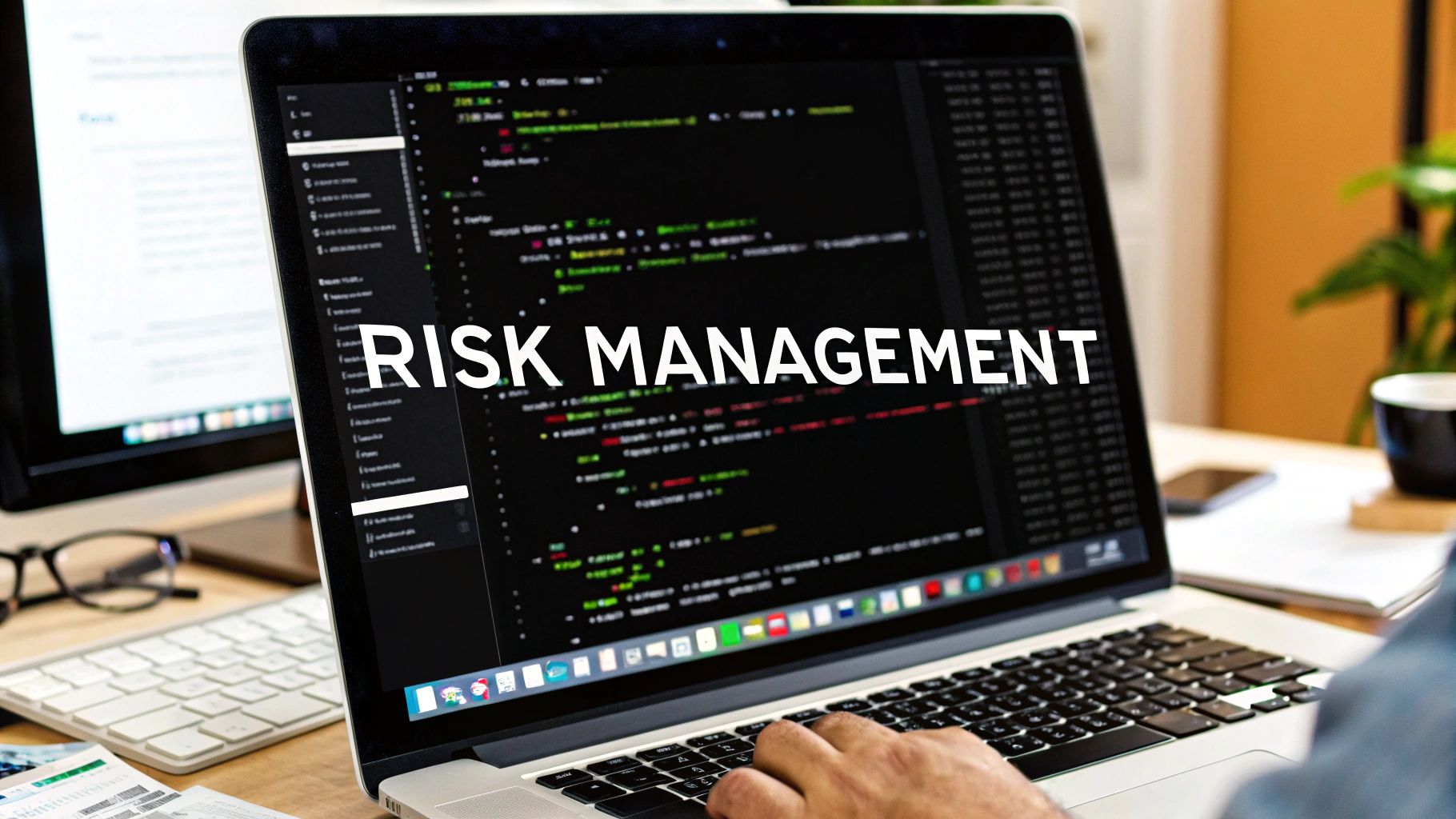Software Development Risk Management: A Comprehensive Guide to Protecting Your Projects
Understanding the Evolution of Software Risk Management

Building software is a lot like constructing a building - while you need solid plans and materials, unexpected challenges can arise at any time. A sudden material shortage or weather delay can throw off construction timelines. Software development faces similar risks that can derail projects, which is why software development risk management plays such a vital role.
The old way of managing software risks relied heavily on spreadsheets and quarterly reviews. While this provided occasional snapshots of potential issues, it doesn't match the fast-paced nature of modern software development. Think about trying to oversee a complex construction project by only checking progress every three months - small problems could grow into major headaches before anyone notices.
The numbers tell a concerning story. Even when following standard risk protocols, 62% of organizations still face significant project failures. Most teams continue using basic tools like spreadsheets and infrequent risk reviews, but problems can surface and cause damage long before being caught in quarterly assessments. For more details on why traditional approaches fall short, check out this Software Development Risk Management Guide.
The Shift Towards Proactive Risk Management
Today's effective risk management requires spotting and addressing potential issues throughout the development cycle - not just at scheduled checkpoints. It's like having an experienced site supervisor who constantly monitors progress and resolves problems before they escalate into major setbacks.
Key Benefits of Modern Risk Management
Teams that embrace modern risk management approaches gain several important advantages:
- Early Problem Detection: Ongoing monitoring helps catch risks early, before they become serious roadblocks
- Improved Decision-Making: Understanding potential risks helps teams make smarter choices about resources and timelines
- Increased Project Success Rates: Addressing risks proactively helps keep projects on track and within budget
- Enhanced Collaboration: When everyone understands the risks, communication and teamwork improve naturally
This forward-thinking approach gives development teams the tools they need to handle complex projects successfully. The next sections will explore specific strategies that are reshaping how teams manage software development risks.
Building Blocks of Effective Risk Management

Managing risks in software development projects requires more than basic assessments - it needs a strong foundation built on proven strategies. Just like constructing a building, your risk management approach must start with solid fundamentals and be maintained throughout the project lifecycle.
Creating Actionable Risk Registers
The cornerstone of effective risk management is a well-designed risk register. Rather than being a static document, a risk register should serve as a dynamic tool that drives concrete actions. It systematically tracks identified risks, their potential impacts, likelihood of occurring, and specific mitigation plans. This empowers teams to focus on the most critical risks at any given time. For more insights, see How to master risk management in software development.
Establishing Relevant Assessment Criteria
Creating clear, project-specific assessment criteria is essential for meaningful risk evaluation. Generic criteria often miss crucial vulnerabilities unique to your project's context. The most effective criteria are measurable and quantifiable, enabling objective analysis of risks rather than relying on gut feelings.
Implementing Effective Review Processes
Finding and assessing risks is only the beginning - you need robust review processes to catch issues early. Rather than limiting risk discussions to quarterly meetings, make them part of your daily development workflow. Include risk updates in stand-ups and sprint reviews to keep everyone aligned. Most importantly, foster an environment where team members feel comfortable raising concerns.
Frameworks for Integrated Risk Management
Recent studies highlight why structured risk management matters: 69% of business executives lack confidence in their current approaches, while 62% of organizations have faced major risks in the past three years. See more details here. These statistics show the clear need for practical, integrated frameworks.
Key elements of an effective risk management framework include:
- Proactive Identification: Look for potential risks before they surface
- Prioritization: Direct resources to the biggest threats
- Mitigation Planning: Create specific action plans for each key risk
- Regular Monitoring: Track progress and adjust strategies as needed
- Continuous Improvement: Keep refining your processes based on results
By implementing these foundational elements, teams can better control risks and improve their project success rates. For related insights, read How to master data-driven decision-making.
Harnessing Historical Data for Predictive Risk Prevention

When it comes to managing software development risks effectively, past project data offers invaluable insights for preventing future issues. By carefully analyzing historical information, teams can identify meaningful patterns and take proactive steps. For example, this data often reveals seasonal variations in project performance or long-term quality trends that might otherwise go unnoticed. Learn more about using historical data effectively.
Techniques for Collecting and Analyzing Data
Getting the most from historical data requires a structured approach that goes beyond simple record-keeping. Here are the key elements:
- Data Capture: Record important metrics consistently throughout each project phase
- Pattern Recognition: Apply analytics tools to find meaningful trends and anomalies
- Actionable Insights: Convert identified patterns into specific risk prevention strategies
These techniques help organizations spot potential problems early and develop targeted solutions based on real evidence.
Building Predictive Models
Creating data-driven predictive models helps teams anticipate and prevent risks before they materialize. These models use historical information to map out likely future scenarios. Here's a practical framework:
| Step | Description | |------|-------------| | 1. Data Collection | Gather comprehensive datasets from previous projects. | | 2. Model Selection | Choose appropriate statistical or machine learning models. | | 3. Training the Model | Input historical data to teach the model to recognize risk patterns. | | 4. Validation | Test the model against new project data to ensure its predictive accuracy. |
Implementing Early Warning Systems
A robust early warning system uses historical patterns to define clear trigger points for key risk indicators. This enables automated monitoring systems to alert teams about emerging issues while there's still time to address them. For practical guidance, check out our guide on How to master data-driven decision-making.
Creating Continuous Feedback Loops
The key to long-term success with predictive risk management is maintaining a cycle of continuous improvement. An effective feedback system should include:
- Regular Updates: Add new project data to your datasets consistently
- Iterative Learning: Use ongoing feedback to fine-tune your predictive models
- Performance Metrics: Track how well your risk prevention efforts work and adjust as needed
By putting historical data to work, teams can build a more resilient project environment where potential issues are spotted and addressed early, leading to better outcomes over time.
Implementing Advanced Risk Management Frameworks

Good risk management goes far beyond basic risk logs and occasional reviews. Well-structured frameworks give software teams clear processes to identify and handle potential problems before they impact projects. By taking a systematic approach, teams can spot issues early and keep projects running smoothly.
Adapting Frameworks to Modern Development
Teams are updating traditional frameworks like Capability Maturity Model Integration (CMMI) to work better with agile and DevOps practices. This means fitting risk assessments into sprints and daily standups while keeping the core focus on finding and fixing problems early. For instance, teams might do quick risk checks during sprint planning or add risk metrics to their dashboards. Research shows that using these kinds of frameworks leads to higher project success rates. Learn more about effective risk management approaches in this detailed research paper.
Integrating Advanced Analytical Tools
Modern risk management uses data analysis and AI to make better decisions. Teams can now study past project data to spot warning signs and likely problems before they happen. These tools also help by automatically tracking risks and sending alerts when issues need attention. This helps teams focus their efforts where they'll have the most impact.
Customizing Frameworks for Your Needs
While established frameworks provide good starting points, the key is adapting them to fit your specific situation. Each team needs to consider their project type, team structure, and company culture when choosing which parts to use. Some teams pick elements from different frameworks to create an approach that works for their unique challenges.
Measuring the Impact of Risk Management
To show that risk management is working, teams need clear ways to measure success. This means setting up Key Risk Indicators (KRIs) and tracking them throughout projects. When teams measure results, they can show the value of their work and keep improving their approach. The data they collect also helps with planning future projects and deciding where to invest resources. For practical guidance on building effective risk management into your work, check out Pull Checklist.
Creating Continuous Risk Monitoring Systems
Modern software development requires a shift from periodic risk reviews to active, real-time monitoring. Teams that catch and address issues early minimize negative impacts on their projects. While many have started using automated monitoring tools, building an effective system that grows with your projects takes careful planning and execution.
Implementing Automated Monitoring Tools
Good monitoring starts with choosing the right automated tools. These should provide instant insights and alert teams when risks emerge. The key is selecting tools that work smoothly with your existing development setup - this helps teams maintain oversight without disrupting their normal workflow. Pull Checklist shows how this works in practice by adding automated checks directly into GitHub's code review process.
Establishing Meaningful Early Warning Indicators
To spot problems before they grow, teams need clear early warning indicators (EWIs). These indicators come from analyzing past project data to find patterns that often signal upcoming issues. Some essential indicators to track include:
- Performance Metrics: System response times and error rates
- Security Alerts: Unusual access patterns that could mean a breach
- Code Quality: Changes in code complexity or defect numbers
Creating Feedback Loops
Strong monitoring systems thrive on feedback that drives constant improvement. This means going beyond just gathering data - every team member needs to actively participate. When cross-functional teams regularly review risk data together, suggest changes, and put those changes in place, the whole risk management process becomes more useful and practical.
Building Sustainable Monitoring Practices
Making risk monitoring last requires smart choices about tools, measurements, and team involvement. Pick tools that can grow with your needs and fit naturally into how your team works. Choose metrics that match your project goals and check regularly to make sure they still make sense. Most importantly, help team members understand their role in monitoring and encourage them to contribute their insights.
These approaches help teams move from occasional risk reviews to active monitoring that catches problems early and keeps projects on track. For more details on building better development practices, visit Pull Checklist, which helps teams manage risks smoothly in every pull request.
Fostering a Risk-Aware Development Culture
Building teams that proactively identify and manage risks is crucial for successful software development. Rather than viewing risk as something to avoid, forward-thinking teams make discussions about potential challenges a natural part of their workflow. This mindset shift not only prevents issues before they arise but also energizes teams to innovate safely.
Encouraging Open Communication
When teams feel comfortable raising concerns early, they can address potential problems before they become serious issues. A real example shows this in action - one development team openly discussed security vulnerabilities they spotted during code review, allowing them to patch the issue before it led to any breaches. Creating this environment requires building trust and making it clear that surfacing risks helps the whole team succeed.
Key Communication Practices:
- Regular Risk Reviews: Include risk discussions in weekly team meetings
- Safe Reporting Options: Provide ways to report concerns privately
- Lead by Example: Managers should actively participate in risk discussions
Establishing Clear Ownership
For risk management to work, every team member needs to know their specific responsibilities. Just like a hospital's emergency response team, having clear roles allows quick action when issues arise.
Essential Steps:
- Define Roles: Document who handles different types of risks
- Track Progress: Monitor how well each role manages their risks
Want to learn more about building risk-aware teams? Check out our guide on Creating a Risk-Aware Culture.
Integrating Risk Consideration in Daily Decisions
Risk assessment works best when it becomes a natural part of how teams work. Think of it like defensive driving - constantly scanning for potential hazards while moving forward. This means evaluating risks at key decision points while maintaining development momentum.
Daily Risk Practices:
- Morning Check-ins: Review potential risks during daily standups
- Team Learning: Run sessions to identify emerging risk patterns
- Early Warnings: Set up alerts for when risks reach critical levels
When teams embrace risk awareness, they can move quickly while staying safe. This balanced approach leads to better outcomes and helps teams grow stronger together.
Ready to improve your risk management? Try Pull Checklist, our GitHub Marketplace app that helps teams catch risks during code review by using smart checklists.
